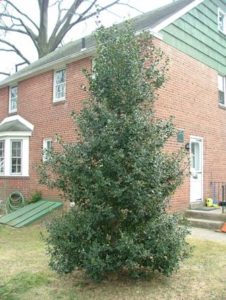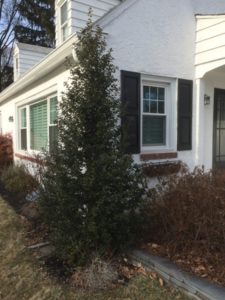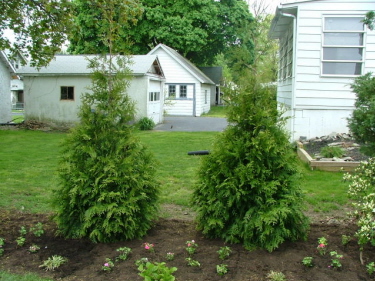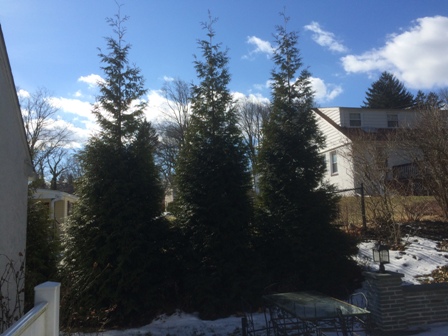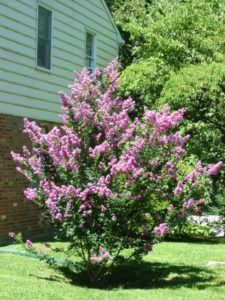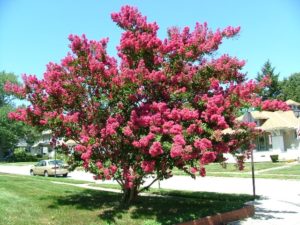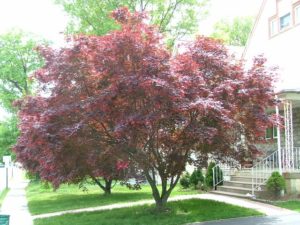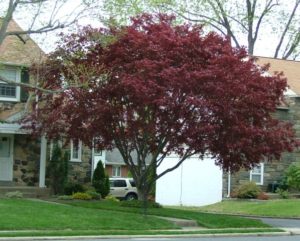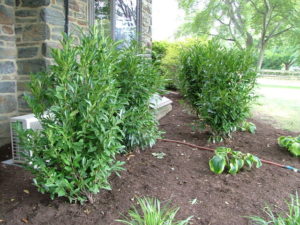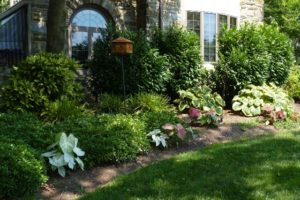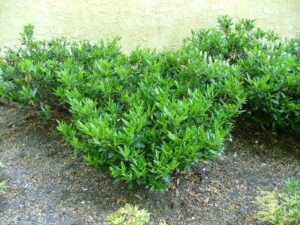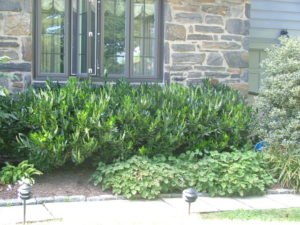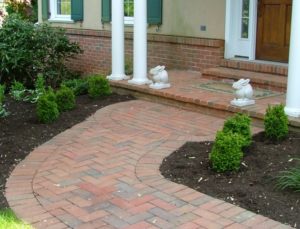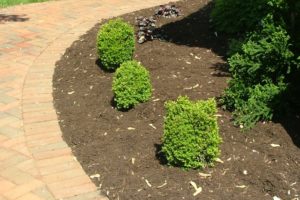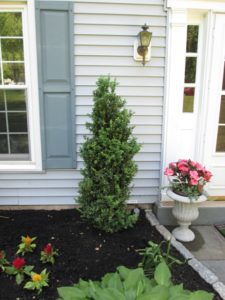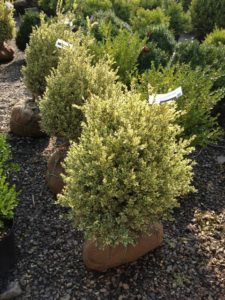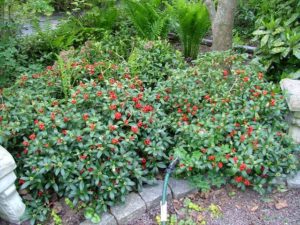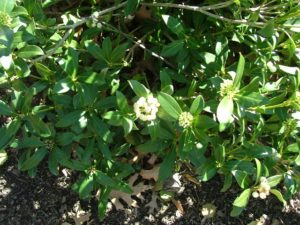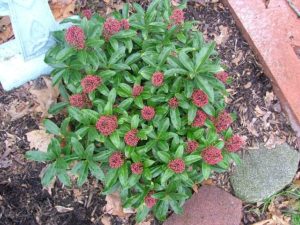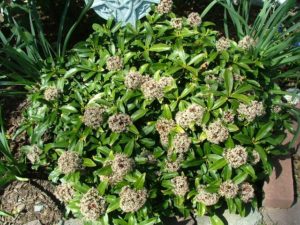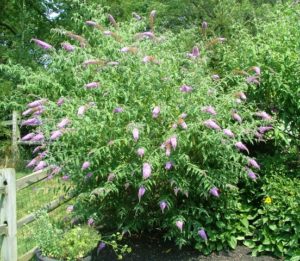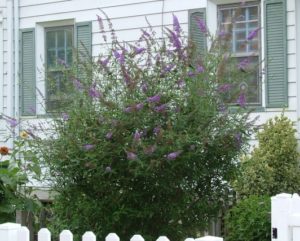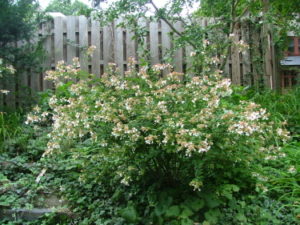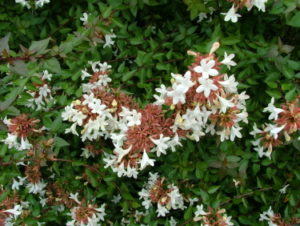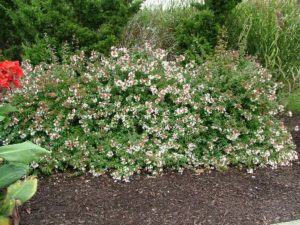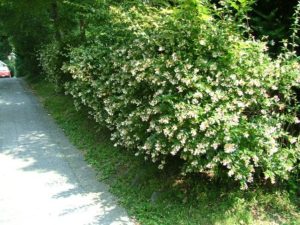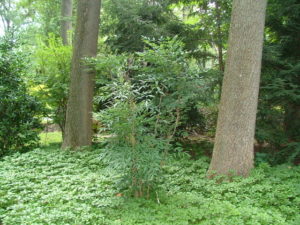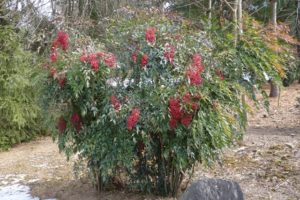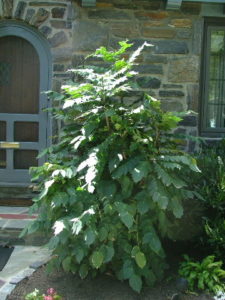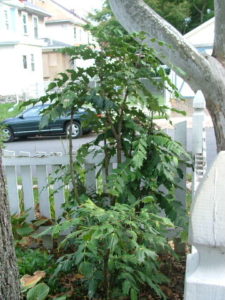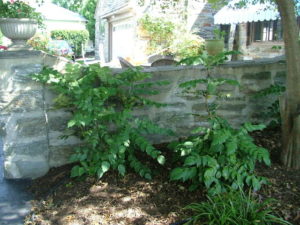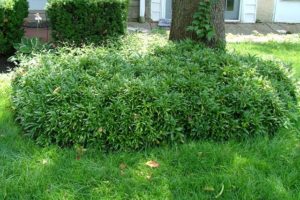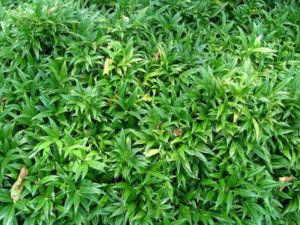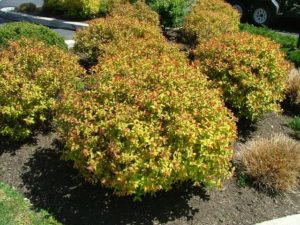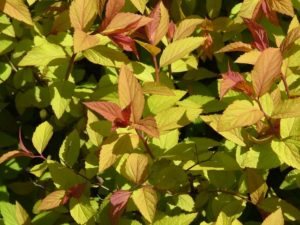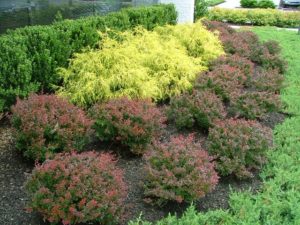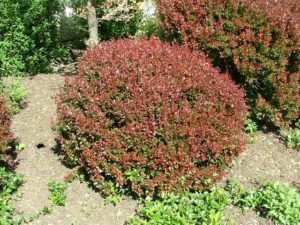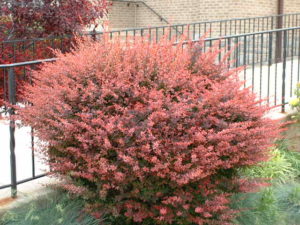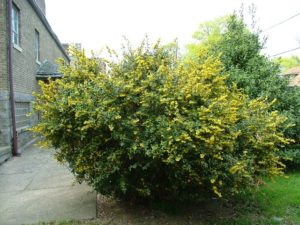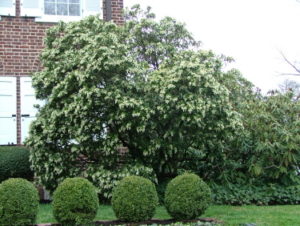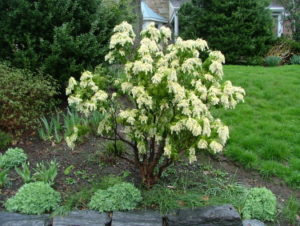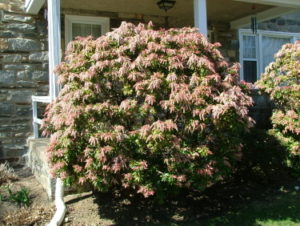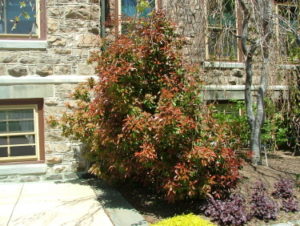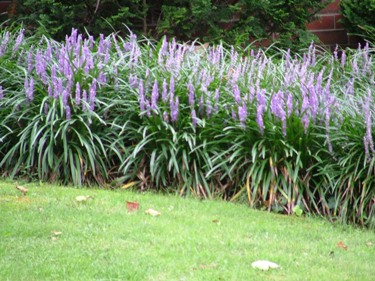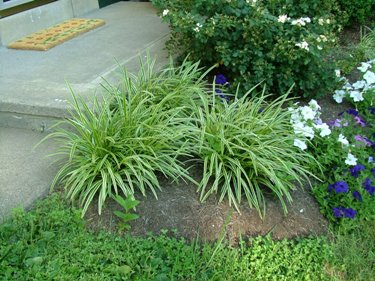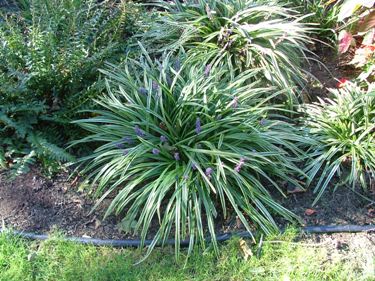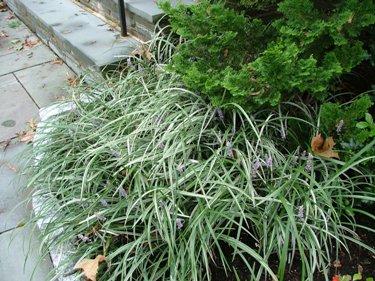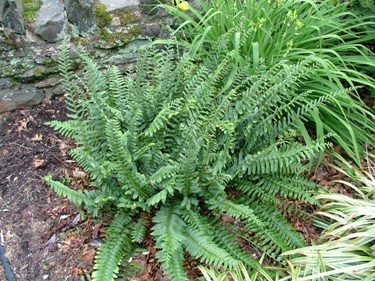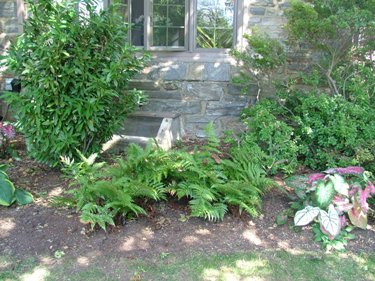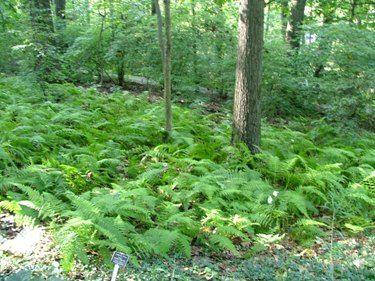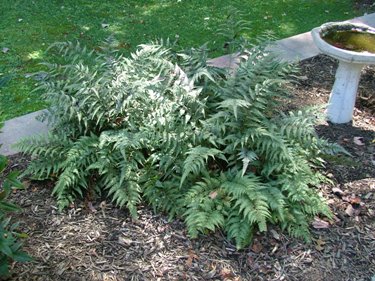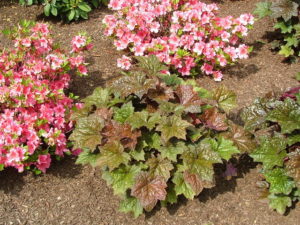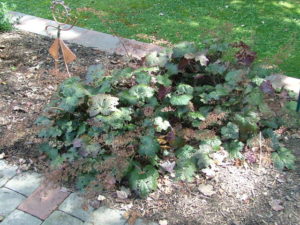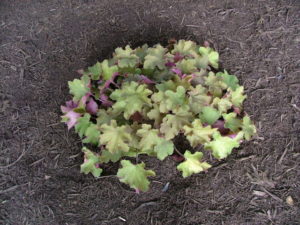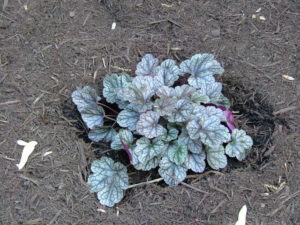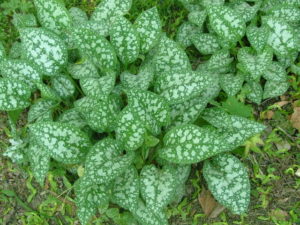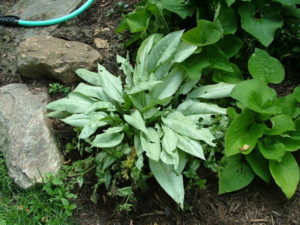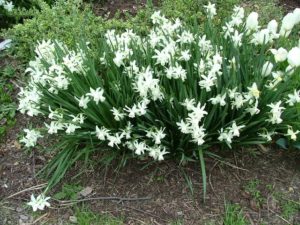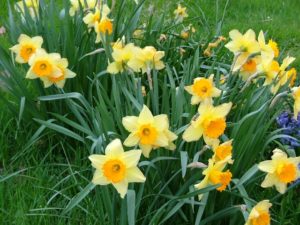I will try to show some deer resistant plants on this page, but like people, different deer have different tastes, so plants that are not bothered in one yard could be a favorite in another. When food is scarce deer will eat almost anything if they are hungry enough. New foliage and young plants can be more tender than older foliage and established plants, so planting very small sizes of plants is not recommended. If you do plant smaller plants – or plants like liriope, which get more resistant to damage as they get more established – it is a good idea to spray a deer repellent on the foliage the first season, until the plant is established. In the same neighborhood, the routes deer take can be fairly consistent, so pressure on one property can be much greater than the house across the street.
Unfortunately like every other page that takes on this subject; I have to write that deer do not read this. They just taste plants and decide what they like, and like us they are less discriminating when they are hungry. You might have to expect a little damage and not depend too heavily on any one variety. I have seen hollies that did not have as pointy leaves as other varieties that have been eaten by deer, while the pointy varieties were left alone. Deer, especially young ones, will try different plants and this can damage plants that they don’t normally eat. I saw one row of ‘Green Giant’ Arborvitae – a plant deer normally leave alone, where the end plant had been damaged by all the tasting, but no other plant in the row had any significant damage.
Here are some other good links:
Rutgers Landscape Plants Rated by Deer Resistance also you can download a PDF from Rutgers with this information.
Here is another site deer-departed.com with 9 or 10 different lists of deer resistant plants.
And another site White Flower Farm has small thumbnail photos of deer resistant perennials – Click on the thumbnail on the White Flower Farms site and you get a larger photo and some information about the plant.
On my blog, I have another page of Deer Resistant Perennials. Click here for my blog page.
Recommended Shrubs and Small Trees
Hollies with sharper spines on there leaves discourage browsing. Shown here are two pyramidal upright hollies and a couple of shrub forms. The moderately growing pyramidal types look nice on corners, and the shrub types are nice evergreen shrubs that look nice in front of brick houses. ‘Dragon Lady’Holly – Very nice form that can be kept under 15-ft and 4 or 5-ft. wide with a little of light pruning once every year or two. I like it on corners where the beds are close to walks for that reason. Fosteri Holly – Gets a little taller and wider than ‘Dragon Lady’ Holly, maybe 20-ft. tall and 8-ft. wide. Because of it size, I would not recommend this near walks or landing.
- Dragon Lady Holly
- Dragon Lady Holly
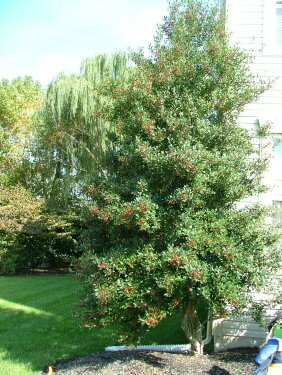
Fosteri Holly with berries
‘Green Giant’ Arborvitae Tall and very fastest grower. Much more deer resistant than other varieties of Arborvitae. A nice variety becoming more popular as a tall screening plant. A good substitute for Leyland Cypress with a somewhat more natural color.
- Shortly after planting. Plants are planted with a little space between them to allow for future growth.
- Here is another planting after a few years. Plants have started to grow together and make a good screen.
Crape Myrtle – Blooms for a long period in Summer when not much else is in bloom. Flowers come in White, pink, purple and red. Flower in summer when most other trees are just green. Very colorful plants with the ends of the braches holding large bunches of flowers that come in pink, red, purple, and white. Habit of the plants can vary from narrow small trees to wide shrubs with multiple stems. There are also dwarf shrubs available. Newer varieties are much better suited to our winters. Older varieties would sometimes die back from very cold temperatures. Great bark in winter and nice foliage in summer. Habit varies, it is sometimes grown as a bushy shrub or a small multi-trunked tree. Generally gets as wide as tall but some trees have a narrower habit. Grows 15 to 25-ft. tall in our area.
Japanese Red Maple A very popular beautiful plant with nice mahogany colored leaves in summer, that are brighter when they first come out in spring and again in fall. Does not grow too tall or too fast, maybe 25 ft. tall in 25 years.
- Bloodgood Japanese Maple – An old standard variety.
- Bloodgood Maple in April
Cherry Laurel – Usually Deer Resistant (occasionally nibbled) – Nice dark green evergreen leaves. Two main varieties are “Otto Luyken” and Schipkaensis.
Schipkaensis (or Skip) Cherry laurel is more upright and faster growing. It can get up to 7 or 8-ft. tall in a few years and can be fairly dense growing. It can make a nice dense evergreen hedge. I think it looks best singly or in small groups mixed with other shrubs. If used by itself as a screen I think it is too monotonous .
- New planting of ‘Skip’ Laurel
- Same planting 6 years later. Also in photo Acuba, Skimmia, Liriope, Hosta, and Caladiums
“Otto Luyken” Cherry Laurel is lower growing, but still dense. It can make a nice lower growing hedge or a nice evergreen foundation plant. It will get up about 3 or 4-ft. high.
Boxwood – Very deer resistant – Dense evergreen plants. Many different varieties, with some very slow growing types. Other varieties like ‘Dee Runk’ grow taller and can be kept very narrow for a different look. There are also variegated types that can add interest.
There is also a nice photo below with the pieris that shows a nice planting of boxwood in front of the first pieris photo.
- ‘Dee Runk’ Boxwood
- Variegated Boxwood at the nursery
Japanese Skimmia – Very deer resistant – Slow growing and low growing evergreen shrub. I have not seen it over 2 or 3 ft. but I have read that it can get taller. Likes some shade, but doesn’t seem to do well with competition. I have seen pachysandra grow over and through it to a point that there wasn’t much left of the Skimmia. It might need to be babied a little when young, but it is worth the trouble. Red berries (also a white variety) in winter and early spring only on female plants, but not usually heavily berried, and I like the flowers on the male plant better than the berries on the female. Male flower buds have a reddish cast that lasts all winter, and open white
- White berried Female plant.
- Male Plant with buds in winter
- Male Plant in bloom -April
Buddleia or Butterfly Bush – Deer Resistant – Blooms from mid-summer thru fall, and as the name says, it is great at attracting butterflies. Colors can range from pink, to lilac, to blue and dark purple. There are even white and yellow varieties available. In this area it seems to grow best cut down hard every spring. If grown without pruning it develops a rough habit, and usually the top gets too heavy for the roots, and the plant start leaning. Luckily, pruning the plant every spring keeps it looking neat and doesn’t hurt it at all.
Abelia – Deer Resistant – is a nice evergreen shrub with small flowers and small dark green leaves that give it a fine texture. It can grow to 5 or 6-ft. The flowers are small, but it usually flowers all summer right up untill frost.
- A close-up of the flowers.
- Abelia still blooming in fall.
- Abelia making a nice 5-ft. Evergreen hedge
Nandina – Deer Resistant – also called Heavenly Bamboo is another fine textured evergreen shrub. A multi-stemmed shrub with small evergreen leaves that can turn reddish in fall and winter. They have small white flowers in late spring and very colorful bunches of red berries during winter (the berries are also long lasting when cut and make nice decorations at Christmas time). The regular variety can get about 6-ft. tall and wide, but there are many cultivars that grow to only about 4-ft. and a few that grower even lower. There are also varieties with plum colored foliage, but these varieties and the dwarfs don’t seem to get the same large bunches of berries.
- Nandina in the shade.
- Nandina with berries and evergreen leaves in winter.
There are many varieties of dwarf Nandina, (with more coming out each year), with some growing to only about 2-ft. high. Shown here is a variety that I like ‘Gulf Stream’ Nandina which can grow 4-ft. high and 4-ft. wide. It is also evergreen and does get some red leaves especially in winter.
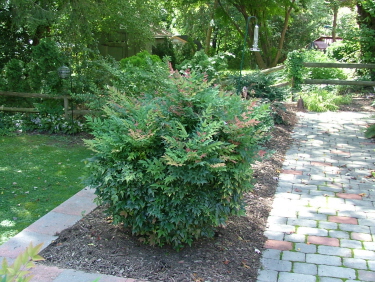
Mahonia: also called Grape Holly. Deer Resistant – This plant has very pointy dark green holly-like leaves. The leaves are larger than Holly leaves giving it an interesting course texture. It can take a lot of shade, and it is usually a multi-stemmed shrub that could grow to about 6-ft. slowly and can be easily kept at a lower height. It is open enough to not give the feeling of a complete screen. It has small yellow fragrant flowers in late winter and blue berries in early summer that are quickly eaten by the birds.
Sweet Box also called Himalayan Box (Sarcococca) – Deer Resistant, Very low growing evergreen (only about 1 ft. high), with dark shiny leaves. It forms a dense mat and can be used as a ground cover. Short enough to be used in front of low windows.
- Close-up of foliage
Japanese Spirea: Deer resistant -Many different varieties of smallish deciduous shrubs. Shown here is a variety that I like ‘Magic Carpet’ Spirea. It grows to about 2-ft. high with a little wider spread. In spring the new foliage is a nice yellow green with the newest foliage on the tips red. It does get purple flowers for a short while in late spring and the foliage stays a nice yellow. It does turn reddish in fall before it loses its leaves.
- New foliage in spring
- Close up of the foliage in spring
Barberry – Very Deer Resistant because of its many small sharp spines – Most commonly seen type is the crimson pigmy with reddish deciduous foliage and small narrow spine that discourage browsing. Crimson pigmy grows to about 3-ft. high and wide. Other similar varieties are ‘Concorde’, which is supposed to grow to only 2-ft. tall, and ‘Admiration’ which develops a nice border of white on the outside of the leaves in the summer. “Rose Glow’ is a taller growing variety that some interesting color mixes in the new foliage in spring. Because of the small thin spines, the plants of these deciduous varieties can look a little dirty in winter after it looses its foliage. There are also some evergreen varieties of Barberry. Seen below is the warty barberry which can get to 6-ft. tall. It has very nasty thorns and a hedge of this will discourage anything from coming through, much less eating any of the nasty leaves. Another evergreen variety is “Willian Penn” which was originally found in Gladwyn, PA. It grows lower than Warty Barberry, has hints of red in the foliage, and even more so in Winter; with the same very nasty thorns.
- Group of Chrimson Pigmy type barberry planted with some golden threadleaf cypress for contrast.
- Chrimson Pigmy type barberry with spring foliage.
- Rose Glow Barberry with new foliage in spring
- Warty Barberry with yellow flowers in early spring
Pieris – Deer resistant. Evergreen with leaves arranged around the stem and drooping a little, sort of like an umbrella. New foliage on some varieties is reddish in spring. Small usually white but sometimes light pink flowers in thin clusters in early spring. Often can have problems with lacebug in this area. Shrubs can get over 8-feet; many varieties are more typically 5 to 6 feet, and dwarf varieties might only grow a couple of feet tall.
- Large Pieris – with boxwood in the foreground
- Pieris – In full bloom
- Pieris – Pink flowering variety
- Pieris – New leaves come out red on some varieties before changing to green.
Deer Resistant Perennials
Liriope – Somewhat Deer Resistant. May need a little protection while being established, as they get more resistant to damage as they get more established – it is a good idea to spray a deer repellent on the foliage the first season, until the plant is established.
Common name Lilyturf: Liriope is a great perennial for sun or shade. It is grown primarily for its foliage and I prefer the variegated varieties. Grass like leaves with blue flowers in August and September. Somewhat evergreen, but can look a little ratty in March, and probably should be cut back before new growth comes in for the best appearance. Does well in full sun, but can take also take some shade.
- Liriope Green – can have larger flowers than variegated variety. Some varieties form a dense ground cover.
- Liriope variegated group
- Liriope variegated with flowers
- Liriope Silver Dragon – a little more open and not asclump forming as the other varieties.
- Christmas Fern – Evergreen fern with dark green fronds.
- Autumn Fern – Evergreen fern – fiddleheads and new fronds in spring have a reddish tint
- Ferns planted as an under story groundcover as commonly seen in nature.
- Japanese Painted Fern – interesting shades and texture.
Heuchera or Coral Bells – Like Liriope I think young plants can be nibbled on, but older plants are more resistant. Newer varieties are grown for their leaves and can take some shade. Leaves grow under 1-ft. high. Flowers on some varieties can get over 2-ft. high. Again it is a good idea to spray a deer repellent on the foliage the first season, until the plants are established. There is a lot of work currently being done with these plants and new varieties and leaf colors come out each year.
- ‘Palace Purple’
- ‘Palace Purple’
- ‘Caramel’
- ‘Silver Scrolls
Pulmanaria – Perennial that can take some shade. It gets nice small flowers in the spring, can be used as a slow growing ground cover. Some varieties have interesting (spilt milk) markings, and variegation on the leaves. Grows under 1-ft. tall. Nice blue buds changing to pink flowers in spring, but flowers are very tight to the plant and don’t last a long time, so the plant is grown mostly for its foliage.
Deer Resistant Bulbs
The classic deer resistant bulb is the daffodil (or Narcissus). The definite go to bulb in deer country. They are almost always left alone by deer, and in the right location they can multiply and outlast all of us. They come in various shades of yellow, white, orange, and even pink shades. I like to use early small varieties of Narcissus instead of crocus (which squirrels will unearth and eat at times). Although Crocus are worth trying – in my last house it seemed we were overrun with squirrels, but they never bothered the crocus. In my current house the squirrels love to eat the crocus. When you plant them, don’t leave them out for the squirrels to accidentally find. Tulips, are beautiful and have a much larger color range, but unfortunately tulip flowers are loved by deer. Tulips are also usually short lived, even when left alone by the deer – and the squirrels and other rodents – which love the bulbs. The later varieties of daffodils can bloom at the same time as Tulips and are a much better choice in my opinion.
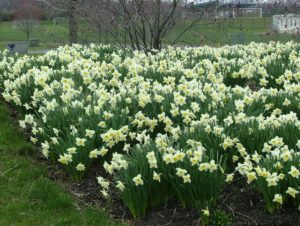 ‘Ice Follies’ – is a great variety for naturalizing. Each one of the tight clumps probably started out as one bulb.
‘Ice Follies’ – is a great variety for naturalizing. Each one of the tight clumps probably started out as one bulb.

